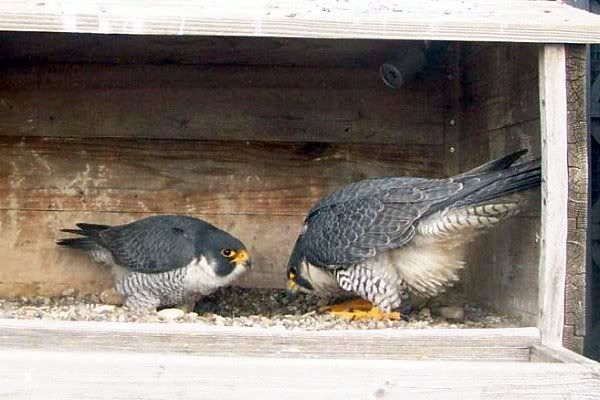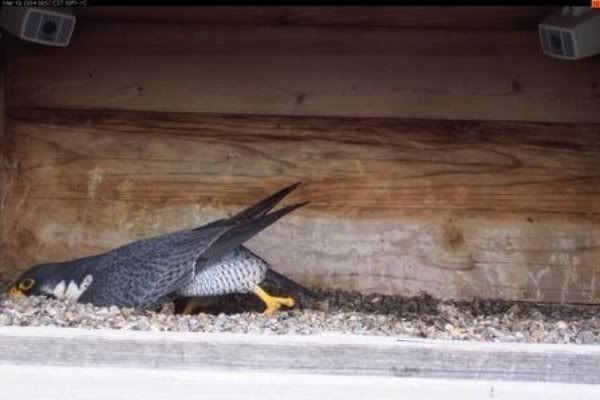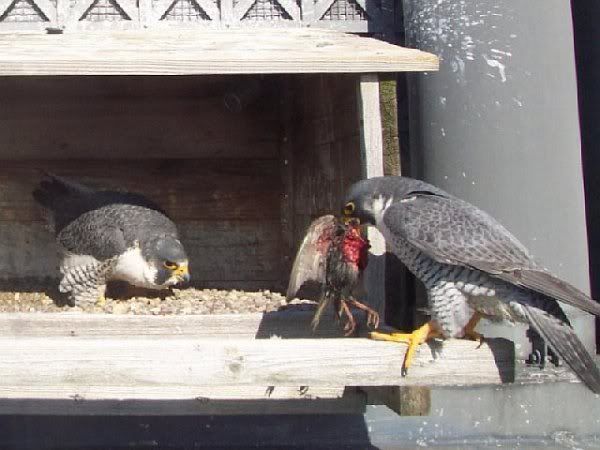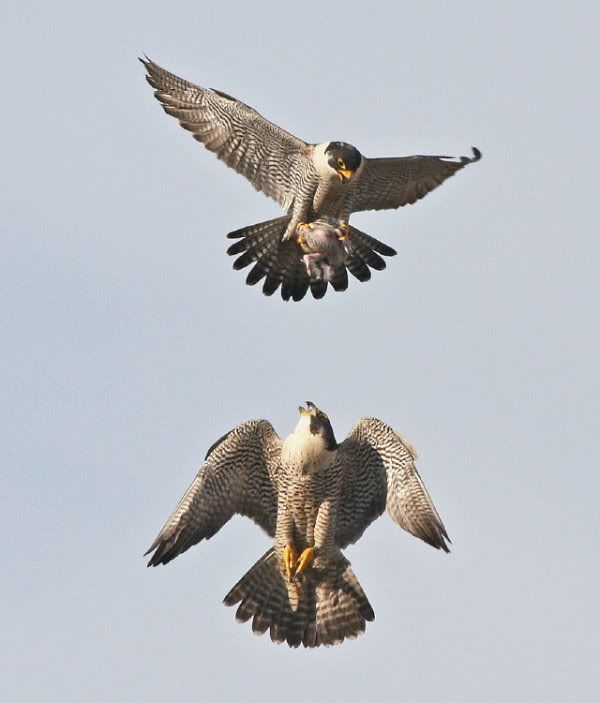
We are all enjoying the courtship period that has started at every nestsite in the Northern Hemisphere. It's wonderful to watch and know that the cold days are almost over and spring is on it's way.
In my post on Midwinter I already mentioned that this was the celebration of the return of the light. It is a very important moment for all life on earth. In every culture this return of the Sun is celebrated in some way. Nature responds immediately on the lengthening of the daylight hours and so do our beloved peregrine falcons. Light triggers hormone production which sets the conditions for the beginning of new life.
DAYLIGHT
When daylength increases nature awakens. Spring is on it's way and that means the start of new life everywhere. The increase of daylight triggers an important hormone production cycle in the brain of animals. And our peregrine falcons feel that as well and so the beautiful weeks of courtship are commencing.

The increase of light is being registred by the Hypothalamus in the brain. Ambient visual cues, such as daylight, activate photosensitive loci in the brain both indirectly, through the eyes, and directly, through the skull. The hypothalamus of the bird brain contains special cells that are sensitive to extremely low light levels, intensities comparable to the amount of light that can penetrate brain tissue.
This lightincrease triggers photic stimulation of the hypothalamus and results in the secretion of Gonadotropin releasing hormone (GnRH below). When activated by GnRH, the anterior pituitary secretes two gonadotropin hormones, follicle-stimulating hormone (FSH) and luteinizing hormone (LH). Both very important androgens.
FSH acts on sperm-producing structures in the testes, while LH acts on the interstitial cells of the testes causing them to secrete the steroid hormone testosterone. The pituitary gland monitors the amount of testosterone in the blood, thus creating a negative feedback loop to maintain hormone levels within a set range.
The same hormones especially FSH and LH triggers in the female the growth of the follicles in the ovaries. By the way, most birds only have 1 ovary, raptors have 2! With th egrowth of the follicles they start producing Estradiol and Progesteron. The latter reacts with LH and triggers ovulation.

Of course both falcon and tiercel show behavioral reactions to the hormone production, which we can watch.
Soon after the return of the light we can watch how they start perching together. Most of the time tiercel and falcon mind their own business, but as soon as the season starts, they become very much aware of eachother. They go out hunting together more often and the male visits the nestbox frequently. After all it is his nestbox, not the one of the female. He starts showing off his aireal skills and soon nestdisplay starts. That is really great to watch.
DISPLAY AT THE NESTLEDGE
PROMINENT PERCHING: both male and female perch in conspicuous positions near the nest ledge. This may very well be accompanied by the Advertisement Wail. This is more frequently exhibited by the male, especially before the female arrives. It is believed to function in mate attraction early in the season and also signals site ownership. The first indication of pair development is mutual perching or roosting, where male and female perch quietly together. This progresses from perching on the same cliff at some distance to perching side by side. In established pairs, this may be accompanied by peeping, mutual preening, nibbling at toes or bill of the mate, or billing, in which one bird turns its head upside-down and engages bill of the other. This can be seen very often in peregrines. Billing is a social behaviour as well. Activity on nest ledge increases as courtship progresses.

BOWING: is a display used in many situations, especially as part of courtship. The peregrin leans forward, head low, often with her tail held high.
MALE OR FEMALE LEDGE DISPLAY: The peregrine stands over the nest depression (scrape), leaning forward (bowing) and making an “ee-chupping” vocalization. The male often stares at the female during a male ledge display. he is making a more "ee-chipping" vocalization. Ledge displays are often accompanied or followed by;
SCRAPING: Either bird can do this, however the male is often the one who scrapes the bowl for the eggs.He runs his breast through the substrate or nest depression, pushing out with its legs behind. The bird is forming the nest cup (scrape), but this is also part of courtship. Scrapes may be made at several potential ledges before the female chooses one of them to lay her eggs in. Peregrines do not build a nest, but rather lay their eggs in such a scrape formed in the nest substrate.
MUTUAL LEDGE DISPLAY: Often this is precipitated by a male or female ledge display. The other bird joins the first on the ledge and both bow and ee-chup over the scrape, sometimes touching bills. This can also happen outside the eyrie.

FOOD TRANSFER: The male offers food to the female by approaching her or standing near, with food in talons or beak, ee-chupping. The female takes the food from the male, usually ee-chupping or wailing. This can happen in the air or perched. The male often signals the female that he has food by wailing as he approaches the cliff or nest. This will normally occur outside the nest box. Peregrines normally do not bring food into the eyrie until they are feeding young, probably so that the nest stays clean.
The offering of food is an essential part of courtship. The courtship behaviour of the tiercel is an important stimulant for the hormone production of the falcon. The more food he offers the more she comes into season. He shows her with these offerings that he is a good hunter, that he will be able to provide for her and her eyases. She has to fuel up for the production of her eggs and as soon as that proces starts she will not be able to go out hunting. So she has to able to rely on him. When the eyases are there se will not leave them for the first 10 days. She has to be sure he will bring enough food for her and her eyases then as well. She will go into molt as well at the end of incubation and that takes an enormous amount of energy as well.
So here he is: the tiercel. He has to convince the female every year again that he is the very best mate there is for her. So even though they are a pair for many years, the tiercel has to go through the selectionprocess again every year. And there might be a time she decides she does not want him anymore and picks another male. For instance when for a couple of years the eggs have not hatched she might drive him out and take a different male. There are always floaters around, young sub-adult males who are eager to take his place. She is and always stays the boss.

Or she will leave herself! When something is bothering her it just might be she leaves him to find a better male at a different nestsite, which very often means a territorial battle. If she finds herself an attractive nestsite and tiercel she just might fight it out with the resident female. But these things do not happen often. Most of the time they stay together for life.
The pairbond by the way is very strong when the pair is succesful in fledging juvs. The bond is not so much to eachother as it is to the nestsite. No romance involved. Just instinct. And there are cases a male has 2 nestsites, 2 mates and even succeeds in fledging juvs from both females. But those cases are rare, but they do exist.
So let's enjoy the courtship these early days of spring. It's a wonderful period and beautiful behaviour of these so magnificent creatures we all love so very much!
The pictures are webcamimages of Mariah and Kaver of the Kodak-Rochester Webcams










1 comment:
Thank you for this wonderful description and the beautiful pictures! It is really moving how these birdscommuniucate with eachother...
Post a Comment